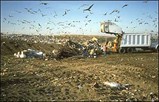Birds and Landfills...What's the Big Deal?

With the birds come a flock of bird-caused problems, including those of safety, health, aesthetics, and others. Although the number and severity of those problems vary, the fact is birds and landfills don't go well together.
"No," the presence of birds at your landfill doesn't mean you're doing a poor job. "Yes," admittedly, some landfills are more prone to bird problems than others.
Certainly those that are near the coast (or other bodies of water) have a good chance of having seagull problems. And, of course, a lack of natural food during certain times of the year can force birds to rely more on the landfill. In coastal areas, for example, seagulls often are more prevalent during the winter months.

In most cases, seagulls are the most common bird pest at landfills—although for many landfills, ravens, crows, and magpies also can be problematic.
If you're new to the landfill business you may be thinking, "What's the big deal with a few birds at the dump?" Well, there are numerous reasons. Here's a short list.
Airport Safety
Birds and airplanes don't mix. Landfills that attract birds and that are located near airports pose a threat to aircraft and its pilot. The Federal Aviation Administration takes the problem so seriously that it won't permit new landfills to be constructed near airports. Pre-existing landfills near airports are closely monitored to ensure that the birds pose little threat to aircraft.
Health and Safety
Bird Bombs, those eight-ounce turkey leg bones dropped from several hundred feet in the air, can hurt somebody. I was in a pickup when one of these clunkers hit the hood. The sound of the impact made me jump, and it also left a dent in the hood. As an aside, the most dangerous time for bird bombs (for example, turkey legs) is the week after Thanksgiving. OK, you've been warned.
Of course, when you have lots of birds flying around, they're also going to poop...on everything and everybody. Besides the offensiveness and mess of the droppings, they create potential health issues as well.
Also, birds can spread diseases by exposing waste that hasn't been properly covered and by picking matter up from the landfill and dropping it elsewhere. Landfills that cover with sandy soil have learned that birds can and will scratch through and get to the trash. This becomes frustrating for sites that are trying hard to avoid litter problems and inspection violations. A short walk along the ridgelines of any landfill with a bird problem will reveal an assortment of (chicken and steak) bones, food waste, personal hygiene products and other things that are better left in the landfill...not scattered around the area.
Certainly from an aesthetic standpoint, birds don't do much for a sanitary landfill's image of being sanitary.
Fish and Wildlife
Coming in through the backdoor, so to speak, problems with some types of birds (like ravens and crows) can lead to bigger issues. The presence of ravens and crows will sometimes attract bald eagles. Guess what? The fish and wildlife folks frown on bald eagles hanging out at your landfill and eating trash. A major siting issue (a few years ago) at a Montana solid-waste facility was that ravens, being attracted by the waste, would become potential attractions for bald eagles.
Beating Back the Birds
Check in next week when we'll go through a rundown on how some landfills are combining various types of bird-control systems to keep the skies safe and clear.
Neal Bolton, a registered engineer, author of "The Handbook of Landfill Operations," and principal of Blue Ridge Services, provides operational consulting for landfills in the U.S. and abroad. He can be reached at blueridge@blueridgeservices.com.
